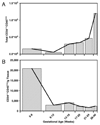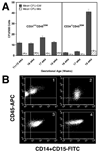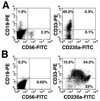A new role for the human placenta as a hematopoietic site throughout gestation
- PMID: 19208786
- PMCID: PMC2731631
- DOI: 10.1177/1933719108327621
A new role for the human placenta as a hematopoietic site throughout gestation
Abstract
We investigated whether the human placenta contributes to embryonic and fetal hematopoietic development. Two cell populations--CD34(++)CD45(low) and CD34( +)CD45(low)--were found in chorionic villi. CD34(++) CD45(low) cells display many markers that are characteristic of multipotent primitive hematopoietic progenitors and hematopoietic stem cells. Clonogenic in vitro assays showed that CD34(++)CD45( low) cells contained colony-forming units-culture with myeloid and erythroid potential and differentiated into CD56(+) natural killer cells and CD19(+) B cells in culture. CD34(+)CD45(low) cells were mostly enriched in erythroid- and myeloid-committed progenitors. While the number of CD34(++)CD45(low) cells increased throughout gestation in parallel with placental mass. However, their density (cells per gram of tissue) reached its peak at 5 to 8 weeks, decreasing more than 7-fold from the ninth week onward. In addition to multipotent progenitors, the placenta contained intermediate progenitors, indicative of active hematopoiesis. Together, these data suggest that the human placenta is potentially an important hematopoietic organ, opening the possibility of banking placental hematopoietic stem cells along with cord blood for transplantation.
Figures





References
-
- Luckett WP. Origin and differentiation of the yolk sac and extraembryonic mesoderm in presomite human and rhesus monkey embryos. Am J Anat. 1978;152:59–97. - PubMed
-
- Tavian M, Coulombel L, Lutton D, San Clemente H, Dieterlen-Lièvre F, Péault B. Aorta-associated CD34+ hematopoietic cells in the early human embryo. Blood. 1996;87:67–72. - PubMed
-
- Tavian M, Hallais MF, Peault B. Emergence of intraembryonic hematopoietic precursors in the pre-liver human embryo. Development. 1999;126:793–803. - PubMed
-
- Charbord P, Tavian M, Humeau L, Peault B. Early ontogeny of the human marrow from long bones: an immunohistochemical study of hematopoiesis and its microenvironment. Blood. 1996;87:4109–4119. - PubMed
Publication types
MeSH terms
Substances
Grants and funding
LinkOut - more resources
Full Text Sources
Other Literature Sources
Medical
Research Materials
Miscellaneous

